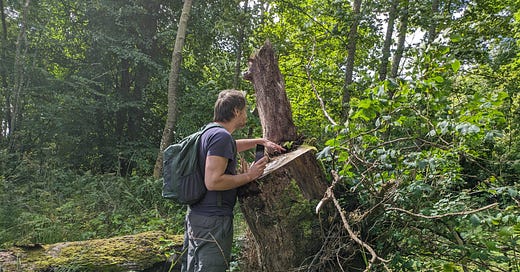I unwittingly stumbled upon Barry The Real Magician* during my elm fieldwork last summer in the Scottish Borders.
He was awkwardly leaning against a fence post with a staff and tiny-lensed sunglasses as we passed on our way through to a site. On our way back about an hour later, he was sitting crossed-legged by the farm gate reading a hefty tome. I jumped out of the van, a rugged picture of a research scientist (or, perhaps more accurately, random scruffy individual bearing a vague resemblance to Father Dougal), being drawn to a wych elm that fit our criteria to be sampled for our survivors’ genetic and propagation work. I couldn’t help but engage with Barry while Emma and Rachel, the expert horticulturists from the Edinburgh Botanic Gardens, listened with interest from the field van.
It turned out Barry was reading Herodotus (Greek historian and geographer, known for writing ‘The Histories’ – a detailed account of the Greco-Persian Wars – and, according to Wikipedia, also referred to as one of the many ‘Fathers of History’). Barry, it transpired, was in fact a real magician who existed on the astral plane all around us, alongside floating creatures with tendrils. He could communicate with these creatures, though, disappointingly, our conversation never went into too much detail about this.
Barry eventually asked about my own business and work, and I explained we were searching for large surviving wych elm to test their genetics and grow new, perhaps more resilient, elm and plant them back into the landscape for restoration. “Ah,” he said knowingly, “eugenics!”. I later learnt that Rachel had overheard this, and had been tempted to jump out of the van to defend the honour of both our work and science in general. Barry would have had no chance.
There are a few fundamental issues, or rather misconceptions, with Barry’s statement. The concept of eugenics is based on beliefs and values which decide, normally unilaterally, what the right path is to ‘improve’ humans through genetic selection, excluding groups judged to be inferior, and elevating other groups; judging them, through unsound reasoning, to be superior. Does that sound like our work of growing new elm trees from ones surviving in the landscape?
Maybe it was simply the mention of genetics that triggered Barry’s misunderstanding. We are examining the genetic similarities of elm populations, the gene flow between populations, and establishing the parenthood of seedlings grown from two resilient elms. I do admit to harbouring a desire to cultivate an Uber Elm that can prove resilient to Dutch elm disease, but I am certainly not alone in this desire or goal.
I would say that the real magicians are the elm, the trees, and plants – and perhaps, also, those people who have an undeniable knack for growing them.
I would like to meet Barry again, and to thank him for making my first stint of fieldwork collecting elm samples unforgettable due to his random presence and loitering. (Is there established rural etiquette regarding how long is too long to be hanging around a single farm gate?)
Anyway, we are currently seeing the first progeny from two resilient elm parents being planted out into the landscape. Hopefully, in time, they might prove the magic of diversity and highlight the potential of genes and adaptation.
*Barry never actually told me his name.
This Week in Trees
This week saw the start of the new academic year at the Scottish School of Forestry. This year, I am leading the BSc Forestry and Treescapes Management programme, and teaching Forest Recreation and Forest Resilience.
I finalised the Food Forest report, which included selecting 125 fruit and nut trees for a planting event around Lock Rannoch in October.




